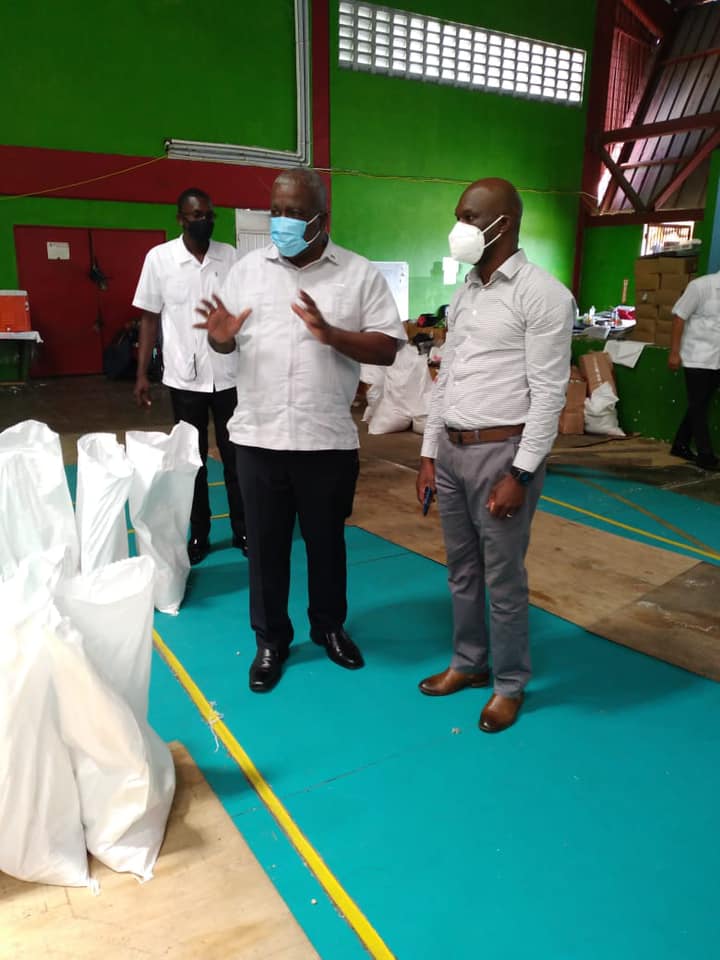With nationwide flooding, ‘building back better’ must be a priority
By Vishani Ragobeer
While it is crucial to provide relief in the form of food hampers, cleaning supplies and shelter to flood-affected residents, Prime Minister Brigadier (Ret’d) Mark Phillips, has said that the government will be focusing on building resilience to mitigate future disasters.
He made this statement on Wednesday after a tour of the National Gymnasium on Mandela Avenue, Georgetown, where the Civil Defence Commission (CDC) has been mobilising relief supplies for flood-affected regions and communities.
The provision of relief supplies has been a central part of the response from the local authorities in mitigating the impact of flooding, which according to the Director-General of the CDC, Lieutenant Colonel Kester Craig, has been recorded in varying levels in all 10 administrative regions of Guyana.
“To date, we would’ve donated over 15,000 hampers,” the Prime Minister said proudly.
He said that some 3,000 hampers have already been distributed to Region Ten (Upper Demerara- Berbice) where the community of Kwakwani, in particular, has been affected by nearly 14 feet of floodwater.

Each hamper, he explained, can feed a family of five for about two weeks. And, he said that the local authorities and some private sector bodies are working with the CDC to continue this relief rollout.
Providing these relief supplies, the Prime Minister reasoned, are crucial to meet the immediate needs of the thousands of flood-affected Guyana. That being said, he, however, noted that the government has a plan for longer-term mitigation planning.
“The recovery phase is where all the mitigatory work will be done, what needs to be rebuilt will be rebuilt, if there is any need for assistance in agriculture, that will be given to the communities,” he said, later adding: “… coming out of a disaster like this, you want to build better so we could withstand the next disaster with a greater level of resilience.”
According to a 2017 Data Collection Survey on the drainage capacity in Georgetown, conducted by the Japan International Cooperation Agency, the 2005 flood which devastated regions Two, Three, Four, Five and Six (the coastal regions) resulted in an economic loss of about US $465.1 million.
Between the years 1971 to 2016, this 2005 flood, or the ‘Great Flood’ as it has been called, recorded the greatest loss due to flooding in the country. These figures alone illustrate the stark impact of flooding in Guyana. The Lieutenant Colonel, during a press conference on Wednesday, highlighted that an economic cost of the ongoing flooding can only be determined when the disaster is managed.
But, he did highlight that from an assessment conducted by the CDC, even when the tide is at its lowest and lands could not drain efficiently since many were within basins that were already waterlogged and could no longer carry the increased amount.
“In many instances, poor drainage, caused by lack of maintenance, damages and insufficient structures and infrastructure exacerbated the situation,” he said. These are structural challenges that have constrained the mitigation efforts.
When questioned if this current nationwide flooding is an ‘eye-opener’ for the local authorities to speedily address these structural challenges, the Director-General responded, “… 2005 was an eye-opener, some measures were taken but some weren’t sustained.”
Now, while thousands of residents reel from the impact of the 2021 flooding, the Lieutenant Colonel said that he hopes that sustained measures will be taken at all levels- in the communities, local government organs, private sector and central government.
These inherent structural problems are not the only issues Guyana has to grapple with, the CDC Director-General pointed out.
“Key for us in Guyana is that we are living in a time when the whole world is affected by climate change and we must start taking adaptation measures because you are seeing not only increasing floods and intensity of rainfall, but you are seeing high winds, we’ve experienced an earthquake a few months ago,” he said.
As such, he posited that efforts need to be focused on building the country’s resilience and investing in risk reduction and mitigation so that fewer resources would be used to respond to the devastating effects of the disaster.
“If we have a resilient society, a society with reduced risk, we would be able to ensure sustained economic development. It goes hand in hand, we can’t want to become a developed country and we are flooded significantly every couple months or years,” the CDC Head emphasised.






